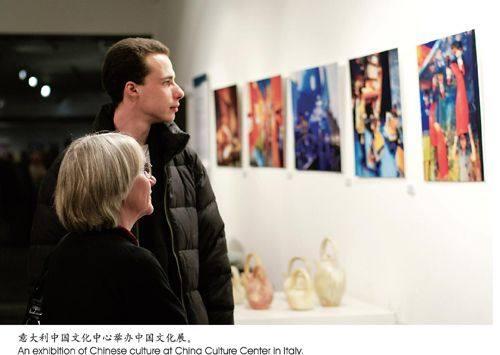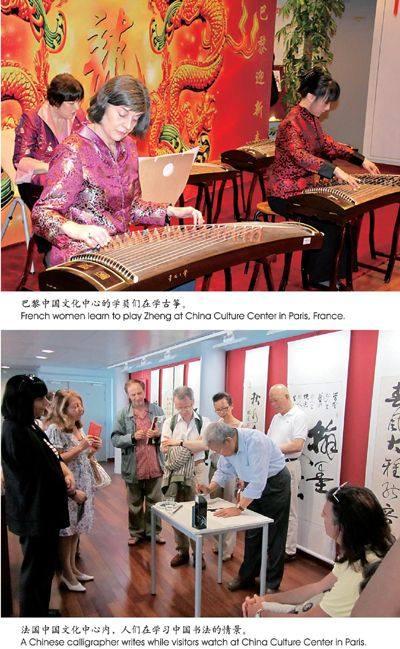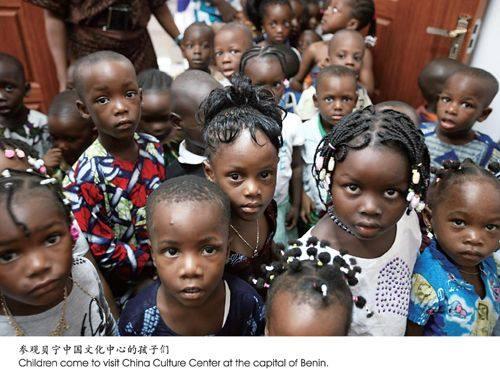热推本国文化的海外文化中心
2012-04-29郭大卫
郭大卫



2012年5月的一天,夜幕降临,贝宁中国文化中心聚满了从四面八方赶来的当地居民。约20时许,武术散打短期培训班结业表演开始,随着《男儿当自强》的音乐响起,几十名男女选手轮番登台表演,台下观众喝彩声此起彼伏。
在贝宁首都科托努,贝宁中国文化中心就坐落在一个古色古香的院落里,大门是一座典雅的中式牌坊,显得格外醒目。这里经常举办演出、展览、讲座、书展、教学和电影放映等活动,吸引着越来越多的贝宁人前来接触和了解中国文化。贝宁功夫学会1993年成立,现在已有3000多名成员,中国功夫已经成为贝宁家喻户晓的“中国名片”。
中国驻贝宁大使陶卫光说,政治制度可以改变,但文化具有传承性和永久性,贝宁青少年通过中国文化中心丰富多彩的活动,深深地被当代中国的历史巨变所触动,要求到中国留学的人越来越多。
贝宁的中国文化中心,建立于20世纪80年代后期。当时,中国政府根据毛里求斯和贝宁政府的要求,在两个国家的首都路易港和科托努分别设立了占地3600平方米和9600平方米的中国文化中心,分别于1988年7月和9月对外开放,到2012年已经整整24个年头。
2000年以后,中国开始在海外大规模建立文化中心,与意大利、法国、日本等国家相比,开始得比较迟,但有赶超之势。中国目前已在巴黎、柏林等主要国际城市建立了文化中心。这些中国文化中心每年共举办大约3000场活动。
中国在海外建立文化中心,正是受到了世界其他国家建立文化中心的启发,并借鉴了其他国家通过海外文化中心推广本国文化的成功经验。
通过海外文化中心来推广本国文化,主要出现在第二次世界大战之后。海外文化中心以各种方式近距离传播本国文化、艺术和历史,广交朋友,联络感情,增强好感,消除误会,是世界各国致力于宣传本国文化的重要窗口。
世界各国在海外建立文化中心有多种形式。有相当多国家建立海外文化中心的首选之地是国际大都市或者别国首都。在一个国际或者地区性大都市,有十几个甚至几十个国家、地区、国际组织的大大小小的文化中心,是司空见惯的事情。以伦敦和巴黎为例,这两大国际都市是各国海外文化中心相对比较集中的地方。
有些国家建立海外文化中心,主要为本国侨民服务,采用会馆形式。这些文化中心一般设置在海外本国侨民聚居地。比如伊拉克在邻国土耳其开设的海外文化中心,目的也是联络侨居当地的伊拉克人。
各国在国外建立的文化中心的名称也不尽相同。有些称为文化中心,有些称为文化艺术中心,有些称为文化旅游中心,有些称为社区文化中心,也有的称为学院、基金会、协会等。总体来说,不同的名称反映了宣传文化方面的侧重和范围,同时也反映了海外文化传播本身的多样性和多任务性。
教授本国语言,宣传本国文化,是很多国家海外文化中心的一大重点。贝宁法兰西文化院是一座园林式建筑,绿草茵茵,花木繁茂。法语是贝宁官方语言之一,到法兰西文化院参加活动的人很多。这家文化院占地7000多平方米。在文化院的儿童图书馆,不仅有数万册图书,还有各种儿童活动设施。这个文化院的活动,是将教育和文化融合在一起的大文化概念。
经过几十年的发展,国外海外文化中心功能逐步完善。有些文化中心以教授语言为主,有些则偏重于文化和艺术的展示和交流,举办各种文艺文化活动,并经常举办培训班。有些文化中心侧重于促进旅游和留学。有些文化中心提供研究机会,有阅览室和图书馆,供学者和热心人士查找资料,了解动态情况。有些海外文化中心经常举办展览,向海外介绍本国的重要历史事件和真实情况。有些海外文化中心,则定期发布新闻,向海外媒体和文化界人士介绍和推广国内文化活动。
有些文化中心还有合并的趋势。例如,韩国目前在海外16个国家有38个语言中心,在20个国家设立了24个文化中心。韩国计划将海外语言中心和文化中心合并运行,以便更有效地推广文化和语言。
有一些国家的海外文化中心数量比较多。资料显示,意大利有89个海外文化中心,法国多达140个,德国的歌德学院在78个国家和地区建有128个国外分支机构。大多数国家的海外文化中心,以政府提供资金和资源为主,企业赞助为辅。如果国家实力雄厚,比较重视,企业热心,则海外文化中心的数量较多,文化活动内容也比较丰富,设备和功能也比较完善。
目前,中国在海外正式开放的文化中心有9个,在建10个,与22个国家签署了建立文化中心的协定、备忘录或声明。5年来,海外文化中心系统、全面、有计划地开展了“大文化”领域的交流活动,每年举办各类文化活动近3000场,文化在国家对外关系中的作用和影响日益彰显。国家“十二五”规划明确提出,要将海外中国文化中心建设成为统筹宣传文化系统与地方文化资源,布局合理、功能多样、内容丰富的中华文化海外展示、体验并举的综合平台。到2020年,中国海外文化中心总数将达到50个以上。
(本文照片由达飞欴提供)
Overseas Cultural Centers: A Cultural Phenomenon
By David Guo
Setting up and operating cultural centers overseas is largely a worldwide cultural phenomenon since the Second World War. These cultural centers function in multiple ways. Windows on national cultures, they promote history, art, culture in foreign countries; they make friends and boost tourism and cultural exchanges.
Cultural centers come in various forms and varieties. It would be very interesting to see where they choose to sit and play. Many cultural centers gravitate toward international metropolises such as Paris and London. In a key international city, it would not be very difficult to see dozens of cultural centers hosted by nations, regions and international organizations. This kind of concentration makes sense. As these cities are culturally and politically important, cultural centers can take the best use of advantages and resources and opportunities there. The presence of these cultural centers also contributes to the cultural diversity and prosperity of these cities.
Some countries set up cultural centers to cater to the needs of their overseas communities. These cultural centers are like home and they usually sit and play in regions and cities where these overseas communities live. Japan operates a series of cultural centers in the United States to cater to the Japanese communities there. These centers offer Japanese language, history, and art to Japanese communities so that Japanese expatriates can learn about their roots and reconnect with their homeland. The Philippines launched in June 2012 in Oman the Middles Easts first “Sentro Rizal”, a cultural center and library dedicated to Philippine national hero Dr. Jose Rizal. The center allows Filipino expatriates in Oman and their children to reconnect with their homeland through books, films and other published materials.
Cultural centers adopt different names. Some call themselves cultural centers directly. Some are art and culture centers; some culture and tourism centers, some community and culture centers. Some have institute, or academy, or foundation, or council in their names. These names reflect the range, focus, and purpose of overseas cultural activities of these countries. They also represent the diversity of cultural promotion overseas. Goethe Institute and Confucius Institute actually fall into a special category of cultural centers that disseminate culture through language learning.
Overseas cultural centers have evolved over decades. Some focus on teaching a language; some hold exhibits and promote cultural exchanges programs; some hold art events; some hold training courses; some promotes tourism and higher education opportunities; some help overseas researchers check through their libraries and reading rooms; some hold regular press conferences about cultural events back home. Some do all these or many of these jobs in different proportions and with different emphasis and enthusiasm in different budgets and sizes.
Some countries are more enthusiastic in setting up and operating overseas cultural centers. Italia has 89 overseas cultural centers; France operates more than 140; Germany has 128 Goethe Institutes in 78 countries; Japan has 22 different organizations run their respective cultural centers in foreign countries. Japan Foundation alone operates more than 20 cultural centers including Japanese Language Academy, Japanese Culture Academy and Japan foundation offices in Europe, Asia, Americas and Africa.
Nowadays, many countries are catching up with the trend of building overseas cultural centers. China is one of them. China is a latecomer in setting up and operating overseas cultural centers. The modernization drive that began in the late 1970s marked the beginning of Chinas awareness of the need to promote Chinese culture overseas. In1988 China set up a cultural center respectively in Mauritius and Benin, two African countries. Through the two cultural centers, China learned how to be culturally close to local residents in foreign countries and how to promote friendship. Over the past 24 years, China has learned a lot about cultural centers and about promoting friendship and Chinese cultural overseas.
In 2004, China began to set up Confucius Institute in foreign countries. So far, there are 358 Confucius Institutes and 500 Confucius Classrooms overseas. They aim to promote the understanding of Chinese language and culture, enhance friendly relations between China and other countries, and promote the growth of diverse world cultures. Confucius Institute is a joint enterprise between Chinese Higher Education Institutes and their foreign counterparts.
Since 2000, overseas Chinese cultural centers are a priority on the national agenda. At present, China operates nine overseas Chinese cultural centers; ten more are under construction; China has signed agreements and memos with 22 foreign countries for setting up cultural centers.
Over the past five years, nearly 3,000 cultural events and shows were staged at the existing Chinese cultural centers overseas, which greatly promoted Chinese culture. The central government and provinces will work together to tap into resources at local level for these overseas cultural centers. People are calling for a top-level strategy for Chinese cultural centers.
